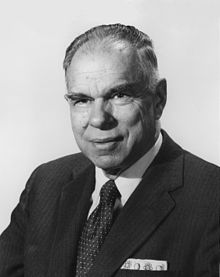User:Nicquetahamilton4/sandbox
Iodine 131
[edit]
Iodine-131 (131I) is a radioactive, known isotope of Iodine that can be used as a treatment for hyperthyroidism and has been a helpful tool for diagnosing many medical conditions.[2] Iodine-131 is a form of beta minus and Gemma emissions. Iodine-131 gives off an electron (beta particle), which then converts into a proton. After the beta decay[3] occurs, the gamma emissions start to occur since the nucleus of Iodine-131 had too much energy for it to be stable. It has a very short half life of 8.02 days, making it very radioactive. Nowadays, the isotope is commonly used for hyperthyroidism. It is when the thyroid gland inflames and produces too many hormones. The thyroid is a gland in the neck that makes hormones to help control some of the body’s metabolic processes, such as heart rate, blood pressure, body temperature and weight. After a small does of iodine-131 is taken, the isotope absorbs into the bloodstream and kills of the thyroid gland's cells. Other radioactive isotopes of this element are Iodine-123, Iodine-124 and Iodine-125. Iodine consists a total of 37 isotopes. The element Iodine alone its self has 53 protons, 53 electrons and 74 neutrons. Instead, Iodine-131 contains 53 protons, 53 electrons and 78 neutrons.
History
[edit]The discovery of Iodine was in 1811 by French chemist Bernard Courtois.[4] He had a little family business that was never much of a success, which was manufacturing salt peter that was made from seaweed ashes. After accidentally mixing too much acid, he had produced clouds of vapor that continued in to forming into a violet colour. When settled on to cold objects, the vapor turned into dark, shiny crystals. Since Courtois did not have the money to mix other elements with this new substance he had made, Bernard asked for help from two other fellow chemist's he knew, Charles Bernard Desormes and Nicholas Clement. [5]After completing the job that was asked in the request, they made the research public in 1813. Gay-Lussac was the person who ended up giving element its name after the Greek word 'iodes,' which means the colour 'purple.' Gay-Lussac continued to study the substance and its compounds. In 1831 Bernard Courtois was given a prize for his work. His factory that consumed gunpowder from the salt peter had failed due to the demand for gunpowder dropping. He continued to make Iodine and sell it, but Courtois died because of poverty after his produce only made little success.

On the other hand Iodine-131 was not discovered until 1938 by two research scientists, Glenn T. Seaborg and John Livingood at the University of California, Berkeley Radiation Laboratory. The new isotope was put to use only several years later. A year after the discovery, a paper had been published including information about how it can possibly be used for medical treatment and diagnostic use. 1946 is the year Iodine-131 was first used as treatment for thyroid cancer, which was a great success. The next year Iodine-131 was used to check for tumors in the human brain. in 1951 the isotope was being used for cardiac blood flow imaging and became the first radio pharmaceutical approved for use by the FDA . In 1955, it was used for diagnosing liver problems and lastly, in 1982, it was first used to treat malignant melanoma.
PMI
[edit]- Iodine-131 is a useful tool to treat and diagnose many medical conditions.
- The treatment is considered to be a low cost.
- It can be very dangerous, especially to children.
- High dosages can cause thyroid cancer. [6]
- There are many side effects that can occur after treatment.
- With the help of beta radiation, Iodine-131 destroys tissue.
References
[edit]- ^ (ACR), Radiological Society of North America (RSNA) and American College of Radiology. "Radioiodine (I -131) Therapy for Hyperthyroidism". Retrieved 2018-07-31.
- ^ (ACR), Radiological Society of North America (RSNA) and American College of Radiology. "Radioiodine (I -131) Therapy for Hyperthyroidism". Retrieved 2018-07-31.
- ^ "The radioactivity of iodine-131". Khan Academy. Retrieved 2018-07-31.
- ^ "Who Discovered Iodine 131?". Sciencing. Retrieved 2018-07-31.
- ^ "The History of Iodine in Medicine Part I: From Discovery to Essentiality, Guy E. Abraham, M.D." www.optimox.com. Retrieved 2018-07-31.
- ^ "iodine 131 interesting facts prezi - Google Search". www.google.com. Retrieved 2018-07-31.

